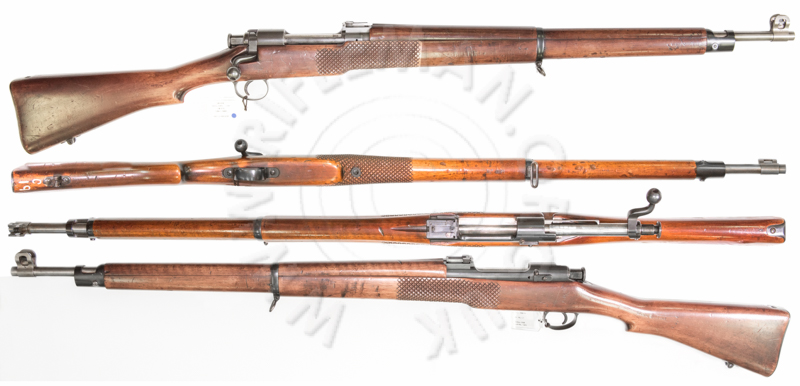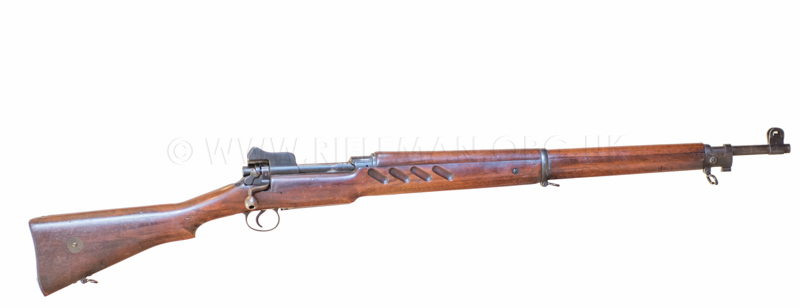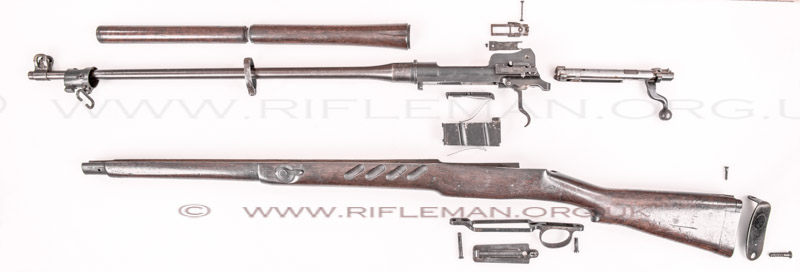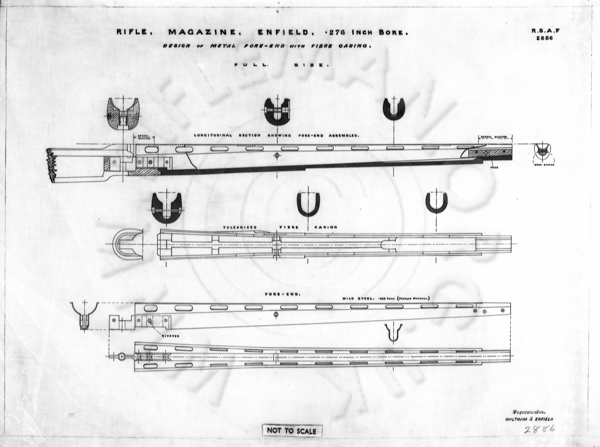Please note that these prototype trials P'13 rifles and drawings are photographed by courtesy of the trustees of the National Firearms Collection at the Royal Armouries, and are copyright to both that institution and to WWW.RIFLEMAN.ORG.UK, to whom the remainder and artwork also have rights reserved.
The Small Arms Committee of the British Government and military was set up in 1900 to oversee advancement in weaponry. Although the design of the 'new' Short Magazine Lee-Enfield Rifle was completed by 1903, and in the process of issue to replace the obsolescent Charger-Loading Magazine 'Long' Lee-Enfield, the Committee was already considering both the choice of design for a new cadet or training rifle in 'miniature calibre' (see the War Office 1906 Pattern Miniature Rifle) and as early as 1910, they were tasked to consider yet another service rifle, with a specific set of configurational differences from the SMLE.
The requirements were for a smaller calibre with higher muzzle velocity and accompanying flatter trajectory. The rifle's locking action was to be forward lugged in the Mauser style, to improve accuracy. The main stock's woodwork was to be one-piece, with just a separate upper hand-guard, and the barrel was to be of greater weight. The final proposal was to include an aperture sight, such as would otherwise not be trialled until ten years later on the conversions of the SMLE to the Rifle No.1 Mk.V.
A number of prototype single-shot rifles, without magazine, were built at the Royal Small Arms Factory. Two of these are held at the Leeds Royal Armouries, now custodians of the original Enfield Pattern Room, to which sealed approved pattern examples of most small arms were submitted as control items to regulate ongoing production at whichever factory was to be engaged for their manufacture.
The two rifles held there are serial numbered "2" and "4".
The collection's brief write-up on each of these two rifles reads:
"Barrel in the white with foresight mount pinned near the muzzle with pierced protective ears. Nose band double-strapped on the top, with another band at the mid-point carrying the front sling loop on the underside. Fully stocked to the nose band, the lower forestock being coarsely chequered below the chamber for gripping. Backsight above the chamber is a ladder type with no markings. Action is Mauser-type with a dog-leg bolt, capable of single shots only with no magazine, though the stock is stepped below the action as on later models. The bolt release catch on the left of the action is retained by screws. Semi-pistol grip stock with steel butt plate and trap, and sling loop fitting on the underside of the buttstock, but the loop itself is missing. Blue finish to some metal parts."
The rifle below is the serial no.2 prototype, which carries the original pattern of chequering.
The hand-cut course design is reminiscent of that used on the Lee-Enfield No.1 Mk.VI,
but with the cuts made at 45 degrees rather than the latter's horizontal cuts.
Zooming into the receiver will show that these first rifles had only a plain machined groove
as a loading platform, and were indeed single-shot only.
Rifle serial no.4 was, however, was assembled without any chequering applied to the furniture.
The rear-sights of these two prototypes are small folding leaves in front of the receiver.
Below left: the rearsight folded down.
right: the ladder upright, with the elevation slide fully down.
This early design of slide lacked the upper strengthening bridge
of the following trials rifles, also incorporated in the Pattern '14 rifle.
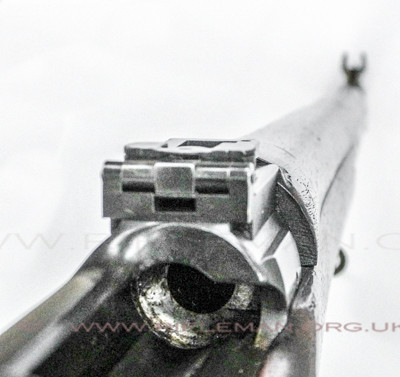 .........
......... 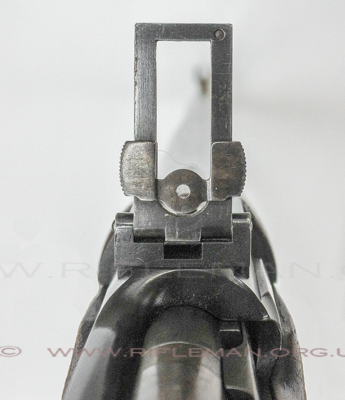
The sight has yet to be moved to the rear with the addition of protective wings.
The incarnations of rear-sight can viewed in the various photographs on this page.
The rifle, also single-shot, shows signs of considerable testing over its working lifetime.
Left: the button at the rear of the cocking-piece can be seen to be fabricated,
with separate sections either side of the centre.
Right: the butt plate already had the bottom-hinged trap
that continued right through to the production Pattern '14 and '17 rifles.
The equivalent traps on the Short Magazine Lee-Enfield rifles were all top-hinged.
The only other British reversal of these was on a very small number of
London Small Arms manufactured War Office 1906 Pattern Miniature Rifles.
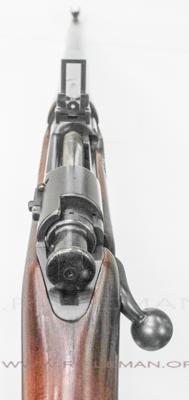 ............
............ 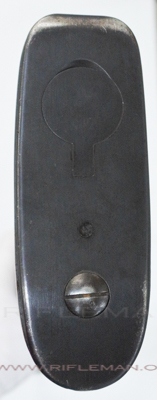
Below left: the bolt-head and bolt-way.
Right: the bolt release catch, yet to include the rear element for a volley sight,
which arrangement appeared on the trials rifles, albeit not calibrated.
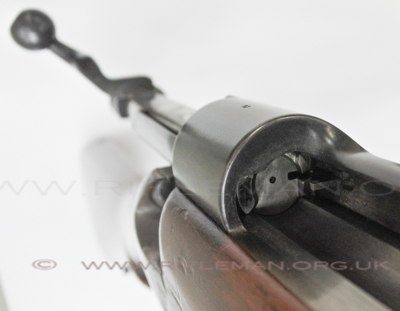 ..........
..........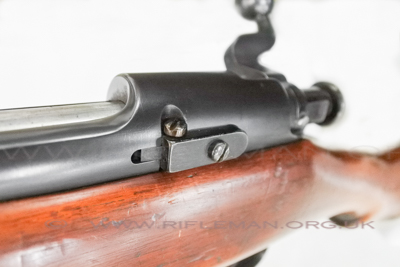
Progression to the configuration of the final trials rifle is shown below,
with rifles now bearing the internal magazine much as it continued
through the production of the Pattern 1914 and Pattern 1917 rifles.
The upper rifle is serial no.1091, carrying the four
fluted angled finger grooves of the 'production' models.
The lower rifle is something of an anomaly in the series.
Being serial no.551, it too has no chequering or figuring to the furniture,
but those more familiar with these rifles will notice
that the rear-sight protecting wings are different in profile.
In fact they have been altered from the high-peaked design of the usual trials models
to a shape particularly close to that used on the Enfield Pattern '14 rifle (No.3).
That this profile was evidently tested either prior to, or within, the manufacture of
the main batch of trials rifles to the upper profile is worthy of note.
Yes, they are both otherwise of P'13 configuration, and of .276-inch calibre.
This unusual example rifle s/no.551 has been elsewhere described as the "improved model".
In the image below of the two receivers, the upper rifle is s/no.551 and the lower s/no. 1091.
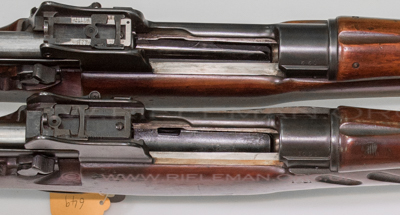
As well as having the P'14 style rear-sight protecting wings,
rifle s/no. 551 has a machined steel magazine loading platform
more or less as fitted to the P'14 production service rifles.
Rifle s/no. 1091 has a plain pressed steel spring-loaded platform
of similar cross-section to the plain solid flute of the single-shot prototypes.
Quite why the earlier serialled rifle has P'14-like features, when those rifles in with serial numbers
in the thousand band that are supposedly later of trials rifle usual configuration,
is open to conjecture - unless you know of the reason.
The June 1951 issue of the journal of the National Small-bore Rifle Association - "The Rifleman"
carried a short piece entitled "The New .280 Rifle" - copied below.
But all long-term hopes came to nought.
The image set we illustrate as our first rotatable example of this rifle is by kind permission of Fultons of Bisley. This Fulton's rifle is an important part of their noteworthy collection. It carries no marks indicating Enfield production other than on the internal faces of the wood furniture, although there is reason to suppose that the barrelled action may be one of those that were reported to have been made by the Vickers Armstrong Company.
The next two images can be rotated and zoomed,
either as initially loaded or full-screen for higher definition.
The bolt of the Fulton's rifle, viewed from above, with a .280 inch cartridge case;

and from underneath.
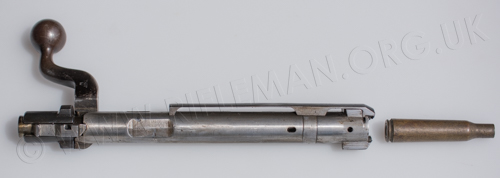
The P'13 bolt face (left) can here be compared with that of the P'14 (centre left)
and (right) the two types of rimfire bolt-head for the .22LR converted P'14/'17 training rifles.
 ...........
...........  ...........
...........  ...... ...
...... ... 
Below: the bolt handle and cocking-piece viewed from beneath.
Although the cocking-piece cannot be used to manually cock the rifle,
it affords the sear engagement and safety catch detent, as well as indication that the rifle is 'cocked'.
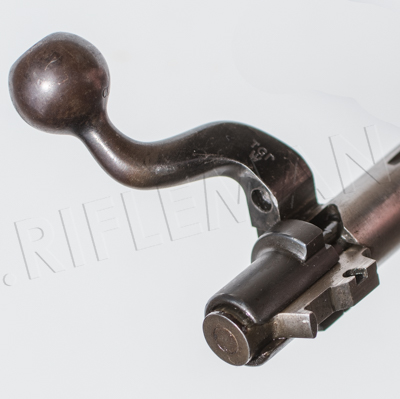
This rifle is unusually devoid of the serial number usually on the bolt, and repeated on the receiver ring,
barrel (beneath the handguard) and the RHS of the stock immediately below the receiver ring.
The receiver ring has a crudely stamped number "777" on the RHS,
possibly over the postion of the original serialling.
As far as we can judge, the early rifles had their serial numbers stamped
immediately above the shoulder line over the gas vent,
while the later rifles were stamped about a quarter-of-an-inch higher.
In place of the serial number on the bolt-handle is the double "R" stamp
with the first R reversed against the stem of the second,
which mark usually denotes an arm with an unsafe barrel.
The mark is repeated on the receiver ring.
Both under the bolt-handle, and on the LHS of the receiver ring, there is a stamp we have yet to identify.
It has "TGr" over "W" and, if you know what it represents, please advise us.
______________________________
One of the main identifying features of the Pattern '13 rifle is evident on this standard trials rifle on display at Warminster, serial numbered 1131, as expected, on both the stock, bolt and receiver.
The total number of rifles manufactured in this configuration was only 1,251, making this a late production example. There were just six further "improved" rifles made, without the singularly identifying four slanting finger grooves in the stock. These are presumed to have been rifles barrelled with a later chamber modification, as problems with the various rimless cartridge designs and pressure required a number of chamber modifications. The finger-grooves are a most unusual piece of design. A not dissimilar heavy fore-end wood grooving, but rotated to the vertical, was to be seen on a following British trials rifle of Enfield design nearly forty years later.
See: the EM-1 and EM-2 Bull-pup prototypes, also of .280 calibre.
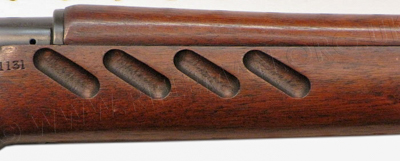
DATA TABLE - ALL MEASUREMENTS AS VIEWED |
||
FIREARM |
IMPERIAL |
METRIC |
| Designation or Type : | Long rifle |
- |
| Action Type : | Bolt (Mauser) |
- |
| Nomenclature : | - |
with serial no. |
| Calibre : | .276 in. |
- |
| Weight : | 8lbs. 11ozs. |
kgs |
| Length - Overall : | 46.3 inches |
cms |
| Length - Barrel : | 26 inches |
cms |
| Pull : | inches |
cms |
| Furniture : | Walnut |
- |
Rifling - No. of Grooves : |
5 |
- |
| Rifling - Twist & Direction: | 1 turn in 10 inches - LH |
1 : ?cms |
| Rifling - Groove width : | 0.0853 inches |
mm |
| Rifling - Land width : | 0.0853 inches |
mm |
Rifling - Groove depth at muzzle : |
0.005 inches |
mm |
| Sight - Fore : | Removeable blade |
- |
| Sight - Rear : | Fixed aperture |
- |
| Sight - Radius : | inches |
cms |
During 1912 an article entitled "The New Rifle" appeared in the journal of the National Rifle Association.
It discussed the situation regarding the then current service rifles, and the requirement for an alternative. There is much supposition about the likely design, configuration and performance of the upcoming new weapon.
The folding aperture rear-sight leaf, of Hythe design, with battle aperture available when folded down, bears a passing resemblance to the first Lee-Enfield use of such a design on the Lee-Enfield No.1 Mk.V rifle, and is unsurprisingly very similar to that eventually fitted to the Enfield No.3 Rifle (or Pattern '14 in .303CF), the range calibration being later adjusted to suit the .303-inch cartridge.
An early design for a rear-sight presumed to have initially been intended for the rifle was in 1910 patented by Fisher and Carnegie, the latter being on the staff of the RSAF, but the likely complexity and cost of manufacture was probably instrumental in the adoption of the simpler eventual design.
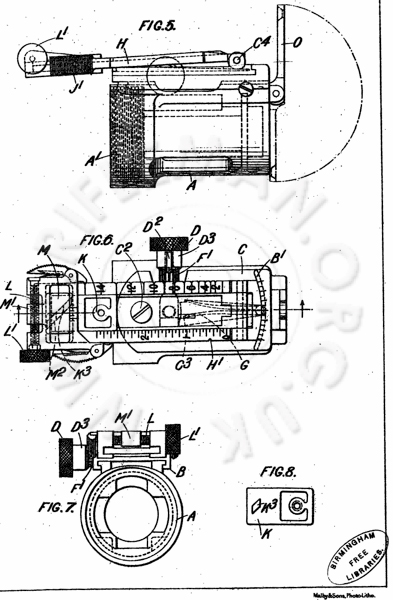
Improvements in or relating to Sights for Rifles and other Small Arms.
19,871. Fisher, F. T., and Carnegie, F. Aug. 25. Sights. - Relates to back-sights for smallarms of the hinged-leaf type in which the sighting-plate is capable of coarse and fine adjustment, and in which one portion of the bed, bearing the leaf, is adjustable relatively to the other portion by differential-screw mechanism, and consists in pivoting the movable portion of the bed so that it can turn about a fixed centre relatively to the stationary part, the movement being produced by differential-screw mechanism. The sight may be mounted on a special cap or nut fixed to the body of the weapon, and may be provided with a separate flap aperture battlesight O, Fig. 3. The movable part C of the bed is pivoted at C(2) to the fixed part B, and is rotated by windage by differential-screw mechanism, comprising a threaded sleeve F, Fig 4, attached to the movable part C, engaging the external thread of the screw D(1), which is provided with an internal thread of different pitch. in which works a screw D(2) pivoted at its end E' to the fixed part B. Suitable click mechanism may be attached to the screw D to indicate the amount of rotation. The slide J, Fig. 6, has spring clips J(1) for coarse adjustment, and to it is attached the aperture sighting - plate K capable of fine vertical adjustment by the screw L traversing the lug M(1) of a plate M provided with an inclined slot M(2), in which slides a stud K(3) on the sighting-plate K.
In the various images of the rifle on this page, note the strong and high sight-protecting upstands on the receiver, all very familiar to those issued with the "P'14" in the First World War, and, twenty years later, particularly to the members of the Home Guard during World War Two.
Here seen with the bolt closed;
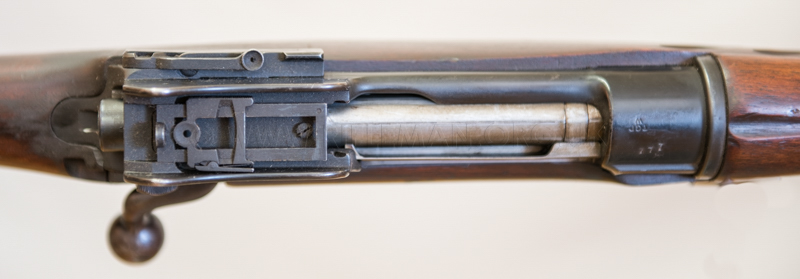
and with the bolt open, showing the solid machined cartridge-follower platform of the magazine.
As the last cartridge has been fired, and the empty cartridge-case ejected on opening the bolt,
the rear of the platform prevents the bolt from being closed on an empty chamber;
a useful prompt to reload!

Which brings to mind the fact that, unlike the Lee-Enfields,
the Pattern '13 and '14 rifles had an integral magazine, but of only 5/6-round capacity,
and not a removable and changeable separate component, as was that of the contemporary SMLE.
This rendered the rifles less capable in a rapid fire situation.
Below: the rimless cartridge ......

....... and the Enfield factory drawing.
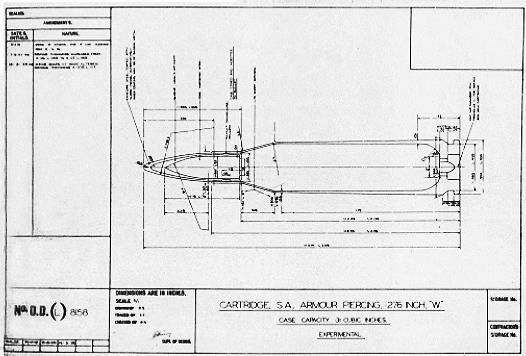
Packets of issued ammunition were marked as being for " S.A. BALL " of " .276 Inch " calibre,
with a " .280" DIAMETER BULLET"
The case head was stamped only with the Broad Arrow and " L"
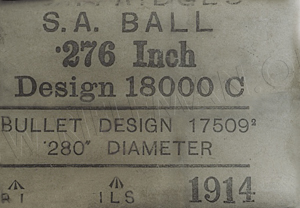 .......
.......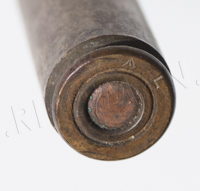
Below: the muzzle of the Pattern '13, with rifling.
The nosecap is different from that finally issued on the Pattern '14 rifle,
and is unique to the P'13.
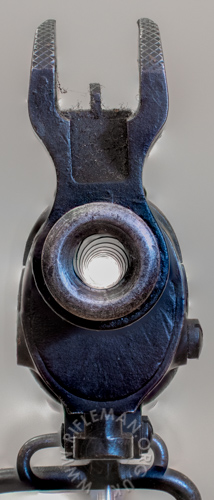
During the First World War (1914-18), a need was realised for armour-piercing small-arms ammunition. Trials with AP .303 rounds had not been particularly successful, and small numbers of commercial heavy calibre sporting rifles were often employed to penetrate targets such as enemy loop-hole plates.
It became evident that the higher velocity .276 calibre ammunition could perhaps have provided a better option, but the break out of the Great War in 1914 brought development of the P'13 and .276 inch ammunition to a halt. The Royal Smallarms Factory at Enfield designed a new rifle on the same lines, but in .303 inch calibre.
This was the Pattern 1914 - "P'14" rifle that was eventually afforded the nomenclature Enfield Rifle No.3. With rifle production in Great Britain already almost at maximum output with the Lee-Enfield Short Rifle (S.M.L.E.), and other small arms urgently needed, contracts were awarded to North American manufacturers for the P'14 rifles. These were undertaken by Winchester, Remington and Eddystone.
The rifle example below, shown disassembled, is P'13 serial no. 210,
quite early in the production run.
In the late 1913 journals of the National Rifle Association (Bisley, England)
there were two articles on the 'New Experimental Rifle".
The first was in the October issue, and the second the following month.
These cover the finalising of trials, and well explain the thinking at the time.
October 1913
THE EXPERIMENTAL RIFLE.
THE NEW SIGHTING.
[COMMUNICATED.]
The experimental rifles have been withdrawn on completion of the annual musketry course, and same improvements suggested are to be carried out. There is a flash on discharge, and the ammunition will receive attention.
While, as regards action and calibre, the experimental new rifle has no feature of novelty, its aiming media indicate a revolutionary advance in military views concerning sights. Doubtless this has been inspired by the demonstration of the enormous superiority of the aperture by Service riflemen at Bisley.
The new weapon will carry about 485 yards with type, which only requires to be white instead of black to fulfil all the requirements of a good field sight. The backsight, mounted over the bolt, is a combination of a fixed elevation aperture battle eight, when folded down, with a tangent elevating backsight, when raised. It does not admit of lateral adjustment, nor of exact adjustment of elevation, while somewhat exaggerated protecting wings tend to slow any sort of adjustment. Military opinion appears to have arrived at the conviction that accurate aiming and shooting in the field is practicable only at such short distances as can be embraced by a fixed elevation or battle sight.
The new weapon will carry about 485 yards with a trajectory which does not exceed 18 inches high at its vertex, about 640 yards with a 36 inch trajectory, and about 820 yards with a 68 inch trajectory, such heights being respectively approximately those of prone, kneeling and standing men.
While an 18 inch trajectory would hit objects of any height exceeding 18 inches sip to about 485 yards, and a 36 inch trajectory objects of any height exceeding 36 inches to about 640 yards, provided aim is always taken at the ground line, it is obvious that both 36 and 68 inch trajectories would carry the ballet over the heads of prone anon for the greater part a their flight. Hence, if the present system of a single fixed elevation battle sight and ground line aim is adhered to, our new rifle, the latest development in flat trajectory weapons, can only have a fixed sight range for prone, kneeling and erect men' of about 485 yards. The alternative on trial at present is to give the battle sight an elevation. whereby a 30 inch trajectory results. Objects exceeding 30 inches thigh are vulnerable to about 600 yards, but to 'hit lower objects reliance is placed upon errors of aim.
Though, in view of the present state of knowledge and powder development, trajectory cannot be further materially flattened, and therefore the battle sight range cannot be sensibly extended by any ballistic enhancement. this result can easily be attained by development of the battle sight, without sacrificing tare essential principles of simplicity and fixed elevation, provided the Ommundsen or negative angle system is adopted. With a combination of negative aim for prone figures and ground line aim for all others a battle sight giving a 86 inch trajectory can be used. and prone figures will be vulnerable to 560 yards. and kneeling and erect figures to about 640 yards. thereby giving oar new weapon the longest battle sight range of any small arm in existence. Surely such an advantage is worth consideration, seeing that the extension of the fixed sight range, is the only point of superiority over the present .303 it is possible for the new rifle to achieve.
With all battle objects vulnerable to 640 yards by means of the battle sight, the tangent elevating sight. which 'will deal with longer distances, claims consideration. Incidentally, while the tangent sight will be of minor importance in the battles of the future, and so far as field shooting is concerned it is immaterial whether it admits of lateral or fine adjustment, it is the only eight applicable to target shooting, and is, therefore, of the first importance from that standpoint. Target shooting is a sport, not it is true having much similarity with field shooting, but a sport nevertheless, and the only sport which induces the practice and study of marksmanship. And good marksmanship in turn, is a condition precedent to good /results, either in the field or elsewhere. For this reason to entirely ignore the claims of target shooting in the design of the new sight would be a deplorable step. While its entire suitability to the circumstances of war need not in the smallest degree be sacrificed to refinements essential to target shooting, its utility for target Shooting can be wholly negatived by the omission of lateral and fine adjustment for wind and elevation. To anticipate objections to these views it may be confidently asserted that the existence of mechanical means whereby exact elevation adjustment is made possible does not necessarily imply that elevation will be so exactly adjusted in the field that errors in estimating distances will not be discounted at least as much as heretofore -or that .the function of adjustment need necessarily be slowed. At the longer distances in the field considerations of hurry and excitement apply with much less force, moreover, direction and lateral accuracy are of so little moment that the effect of shooting 'with the wind gauge out of centre -would be as likely to be beneficial as otherwise.
Though it may bo desirable to enforce the practice of aiming off When necessary by resorting to an unadjustable sight, it is recognised that in the field the practicable limits of aiming off are very small, whereas in fixed distance target shooting circumstances frequently necessitate allowances exceeding the width of several targets.
This would be rendered so uncertain without the aid of a correcting medium in the shape of a laterally
adjustable backsight as to destroy all the pleasure and in many cases, even the possibility, of target shooting. The windgauge and fine adjustment question has been exhaustively thrashed out in the past, and the present British service sights have mechanism for both. No
evidence is forthcoming that shooting with refined sights in the field es elsewhere is inferior to that with the crude sights which characterise Continental firearms. On the other hand English shooting at targets is infinitely superior to Continental shooting, and no grounds exist for supposing it is or will be inferior .on the battle field. Great Britain has more practical experience of war than any Continental nation. Let England lead. To follow the example of nations who are not our equals in shooting of any sort, by reverting to their crude aiming devices on the last word in military small-arms is a retrograde step for which there can be no justification.
THE RIFLE DESCRIBED.
The military correspondent of the " Pioneer " gives the following description of the new rifle, which is now in the hands of those specially selected to try it. A series of satisfactory tests 'have been carried out by the Munster and Suffolk battalions, the 5th Dragoon Guards and other units. The barrel is a couple of inches longer than the present pattern, and is therefore a better proportioned rifle than the short small arm. These two inches have, of course, a greater use than that of mere ornamentation, although of course the short rifle calls for no affection on the score of beauty. The greater length of barrel allows the proper consumption of the gases, so that in the new pattern there is a reduction in the " kick," and a little less violence in the muzzle discharge. In fact, the escape of the bullet from the barrel is a smooth process in comparison, and this will restore any slight inaccuracy which was lost when the old barrel was reduced. Of course, no one wishes to have a target. shooting, small arm on service. but at the same time accuracy need not be thrown away. One is reminded of the stopping of 4,000 Zulus by the good use of a rifle in the hands of Sir Evelyn Wood. The rushes of the impi were only kept down by shooting the leaders, but one warner who seemed to bear a charmed life was coming on with a fine rush, the bullets falling clear of him. Wood, knowing the defects of the rifle, took one, made allowances, and killed the leader, his successor, and a third leader, and the attack died away. And one also remembers the nervous tension experienced when well-aimed single shots are telling every time. Our own men in South Africa used to fidget when the officers went down with accurate Mauser bullets. However, the new rifle is an accurate one of .276 bore and is a couple of ounces lighter than the present small arm. The barrel comes clear of the woodwork in the last few inches towards the muzzle, and in appearance the rifle looks like the Mauser but without the extra ounces associated with the Boer sir all arms. The foresight is of the barleycorn order, with protecting horn flanges, and the backsight is placed behind the bolt and close to the eye oil the firer, so as to get a long sight radius. The aperture in the bar, of course, simplifies aiming, but the open sight can also be used. The " peep," however, makes the sighting semi-automatic, and the steady ,holding of the foresight upon the object is all that the soldier will have to learn. The loading is by clips of five cartridges. The ammunition, of course, is of the high explosive variety, and the bullet is about 176 grains. The shape is of the decidedly pointed kind with sloping shoulders---a bullet that no doubt will often turn over in flight and give a " keyihole " wound. The trajectory is very low, little above the height of a man at any point, and the velocity is little short of 3,000 feet. I expect to see the normal cartridge range at about 2,850 o" 2,900. Firing at 500 yards, the bullet goes easily through an iron plate three-eighths of an inch thick, and as for grouping I can safely say that the rifle is a revelation. I like the balance of it, and one looks forward to seeing it in Buse at Bisley in the match rifle competitions. Private Cook, the U.S.A. champion, and others, did well at Bisley in these events with the service Brag Jorgensen as issued, and our new rifle can, I think, hold its own also.
November 1913
THE EXPERIMENTAL RIFLE.
FURTHER TESTS TO BE MADE.
The well-informed Army correspondent, of The Pioneer, continues in that journal his discussions of the new rifle. He says:—
THE NEW RIFLE TESTS.
With regard to what I mentioned last week about the new rifle. the authorities have decided that further experiments are necessary, but whether with this rifle or with an entirely new weapon of automatic design has not been definitely ascertained. Certain it is this decision had caused the most wide-spread surprise, for the -reports made on the new rifle at the end of the experimental course at Aldershot, where two 'companies of infantry and a squadron of cavalry were armed with the rifle and put through a 'month's course on the range, were eminently satisfactory. The tests applied to the weapon were of a very severe nature, inasmuch as no one was allowed to clean the weapon once the course was started, the barrel standing the test of firing several hundreds of rounds in all sorts of weather fihrorugthout the period in a manner that proved it to be of a remarkably durable metal. the fouling and neglect having no appreciable effect on its accuracy. The sights were proved to be a vast improvement on those already in use, the aperture back-sight being placed so close to the eye as to act almost as an orthoptic, focussing the vision on the target so clearly and with such certainty as to increase the rapidity and accuracy of aimed fire by fully twenty-five per cent. That the severity of the tests imposed should have revealed defects was only to be expected, but so far as the ordinary serving soldier is concerned the defects revealed were of the most trivial nature when compared with the improvements. But it is abated that the higher explosive charges of cordite necessary to ensure point blank range up to 600 yards resulted in
not only highly vivid flashes on discharge, but also to loss of penetrating power when rapid fire is used. This has been brought about by the great heat generated in the chamber affecting the explosive in the cartridge when firing. This defect 'would be accentuated by the adoption of an automatic rifle, with an increased rate of fire, so the problem that is agitating the minds of the authorities deals with the use of a new explosive for the rifle, as -well as the adoption of a new pattern of automatic rifle with which the Hythe staff' as been experimenting this year.
An unusual aspect of the development of the Pattern 1913 rifle
was a proposal for a metal fore-end with a fibre insulating internal jacket.
A drawing of the components was produced at Enfield,
and presumably an experimental example was made,
with trialling evidently resulting in its not being approved for whatever reasons.
Here is a list of the main differences between the P'13 trials rifles
and the production P'14 service rifle,
(apart from the obvious change from .276 to .303-inch calibre)
1. The nosecap was of a unique design not seen other than on the P'13 prototype and trials rifles.
2. The initial peaked profile of the rear-sight protecting wings was not used on P'14 production weapons.
3. Rear-sight calibration on the P'14 was obviously altered for the .303CF round.
4. Rear-sight relief chamfer on P'13 at ladder top for finger lift.
5. Rear-sight fulchrum pin of P'13 not held by nut on LHS.
6. Fore-end finger grooves on P'13 (4 slanted) to fore-end
7. Cocking piece of P'13 sharp edged flat end (radiussed on P’14).
8. Front volley-sight range plate of P'13 trials rifles not calibrated.
9. Bolt handle on P’13 has an outer crank and knob ¼” further to the rear.
10. .276 extractor for rimless case covers greater % of head circumference; the P'14 extractor for the .303 rimmed case was only approx. 0.240” wide.
11. Unlike later P’14 rifles, the rear of the P'13 magazine platform is radiussed, and the bolt can still be closed when the magazine is empty.
The P’14’s had a square-ended rear to the platform, which prevented the bolt from being closed when the last round had been fired, extracted and ejected. (N.B. The Enfield No.3T (P'14) ‘scoped sniping rifle still had its P’13 type platform.
12. P’13s were of Vickers manufacture and without mfr. markings, except for the Winchester trigger-guard and butt-plate.
13. The P'13's rear hand-guard is not fitted with the cross-pin used on the P’14.
An unusual aspect of the history of the Pattern '13 rifles, involving the conversion of some to .303-inch calibre, was the modification of one to an Olympic style "Free Rifle". This work was undertaken by J.C.J. Knott, a then well-known gunmaker and fine target shot. Indeed, he later converted Pattern '14 rifles as Free Rifles specifically for the Olympics in 1948.
The converted Pattern '13 rifle he built was sold at auction by Canada's "#1 auction house" in 2019, and is illustrated below. It has the straightened bolt handle of his later P'14 conversions, and has the rear-sight protecting wings entirely removed, with the receiver top having been suitably radiussed.
The rifle's action is fitted with his own double set-trigger mechanism, and the whole is finely furnished with a thumb-hole stock by his in-house stocker who produced much of the excellent wood furniture used on many of both Knott's full-bore and small-bore target rifles.
Greater detail of John Knott and his rifles can be found HERE.

The rifle was missing its adjustable butt-plate and hook, and had been fitted with telescope mounting blocks. The target aperture rear-sight is the model manufactured by the U.S. Vaver corporation of Chicago, accompanied by a sizeable contemporaneous tube fore-sight.

The fore-end carries Knott's own design of accessory rail with a further multi-holed accessory attachment rail combined with the trigger guard, to accommodate adjustment for sling swivels, a hand-stop not here present, and for fitment of the palm rest for free-rifle offhand competition..

Knott's customary engraved faux ivory cartouche is let into the fore-end ahead of the sling swivel. The initials K-B were those of his own surname, and that of his then partner - Broughton.
See: John Knott and his rifles
The earlier discussion on the subject of armour piercing ammunition neatly links to the next topic.
The PROTOTYPE "AINLEY" ARMOUR PIERCING RIFLE
Please note that Ainley rifle has been photographed by courtesy of the trustees of the Small Arms School Collection at Warminster, and are copyright to both that institution and to WWW.RIFLEMAN.ORG.UK, to whom the remainder also have rights reserved.
The Infantry & Small Arms School Collection at Warminster also holds a most unusual variation of what is catalogued by them as a Pattern '13 rifle. This a not unreasonable annotation, as the rifle is evidently built around a heavily modified version of the Mauser action on which the trials P'13 and production P'14 rifles were based.
In the mid-1930s the War Office was preparing for a potential requirement for the use of small-arms to combat light armoured vehicles. Already in the pipeline was Captain Boys' design for an infantryman portable purpose-built anti-tank rifle, and his Boys .55 calibre Anti-Tank Rifle is covered on this site, including in its several prototyped configurations.
Another option, even more portable, was a high powered individual infantry weapon. A separate development team at Enfield was led by Captain J.R. Ainley, and, in common with Captain Boys' anti-tank rifle, the resultant high velocity weapon shown on this page became known as the "Ainley Rifle".
Very shortly before the commencement of the Second World War, in mid 1939, the trialling of two prototypes was already under way. The proposal had been for a weapon producing a muzzle velocity in the region of 3,700 feet per second, and the testing of various calibres of ammunition up to this point resulted in the selection of a .276 inch cartridge. The calibre of this round, however, was the only similarity to that of the original P'13 rifle; it was effectively a magnum cartridge.
Two prototypes were built at Enfield and, subsequently, orders for four trials rifles were given; two for production by the Birmingham Small Arms Company, and two by Accles & Shelvoke Ltd. The former two were serial numbered 3 & 4, and the latter pair 5 & 6. No.3 is the Warminster rifle illustrated on this page, and No.4 was originally in the Enfield Pattern Room, but now lies in the National Firearms Collection at the Leeds Royal Armouries.
These images are here shown by kind permission of the O.C. , S.A.S.C. Weapons Collection,
and are joint copyright to the Small Arms School and www.rifleman.org.uk.

The rifle bears, on the LHS of the butt, SAC brass tag number 1160,
and is labelled as Experimental, being to Enfield Drawing No. DD (E) 2012

The top of the receiver is engraved with the Enfield drawing number, beneath which is the probable serial no. "3".
The configuration of the rifle could be considered almost sporting, or certainly of later military design,
with its trimmed back fore-end wood, and indeed hints of the
1971 7.62mm NATO calibre L42A1 sniping conversion of the Lee-Enfield Rifle No.4,
and the associated L39A1 military target rifle.

This rifle is more fully covered on a separate page here:-
THE AINLEY HIGH-VELOCITY ARMOUR PIERCING RIFLE
with drawings, references and minutes of the Ordnance Board Proceedings on the rifle's trialling in 1939.
Further detailed information on the nominal .280 inch ammunition, and much more, can be found
on the comprehensive website of the late Tony Edwards, which site is presently residing here:
See also the Enfield No.3 Rifle (Pattern 1914) training version,
an extremely rare British WW1/II Sniper version of the P'17 rifle
and the Soley Arms Co. Experimental adaptation of the P'14 (No.3) Rifle
plus the Lee-Enfield Rifle No.1 Mk.VI
